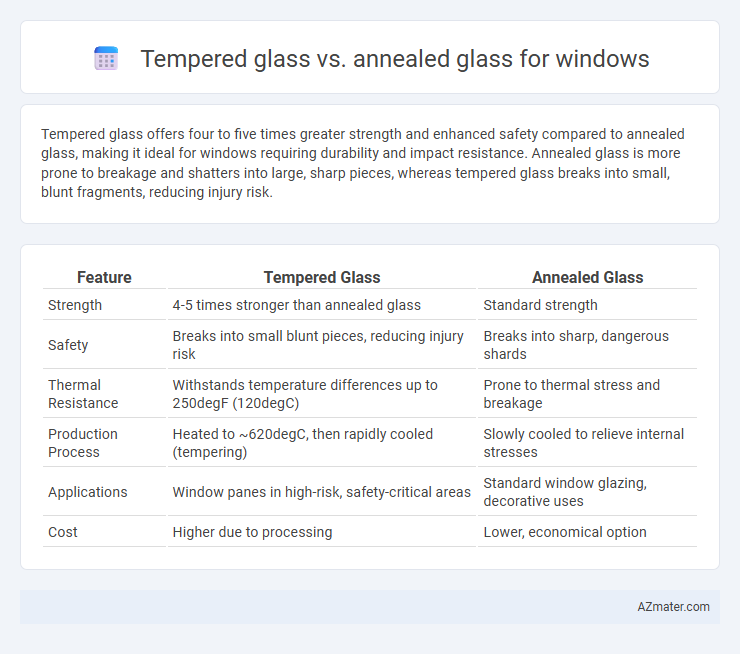Tempered glass offers four to five times greater strength and enhanced safety compared to annealed glass, making it ideal for windows requiring durability and impact resistance. Annealed glass is more prone to breakage and shatters into large, sharp pieces, whereas tempered glass breaks into small, blunt fragments, reducing injury risk.
Table of Comparison
| Feature | Tempered Glass | Annealed Glass |
|---|---|---|
| Strength | 4-5 times stronger than annealed glass | Standard strength |
| Safety | Breaks into small blunt pieces, reducing injury risk | Breaks into sharp, dangerous shards |
| Thermal Resistance | Withstands temperature differences up to 250degF (120degC) | Prone to thermal stress and breakage |
| Production Process | Heated to ~620degC, then rapidly cooled (tempering) | Slowly cooled to relieve internal stresses |
| Applications | Window panes in high-risk, safety-critical areas | Standard window glazing, decorative uses |
| Cost | Higher due to processing | Lower, economical option |
Introduction to Tempered and Annealed Glass
Tempered glass is a type of safety glass processed by controlled thermal or chemical treatments to increase its strength compared to annealed glass. Annealed glass, also known as heat-strengthened glass, is slowly cooled during manufacturing to relieve internal stresses, making it less prone to breakage but weaker than tempered glass. Tempered glass shatters into small, blunt pieces upon impact, enhancing safety, while annealed glass breaks into sharp shards, posing higher risk.
Manufacturing Processes: Tempered vs. Annealed Glass
Tempered glass undergoes a rapid heating process at approximately 620degC followed by swift cooling, which creates compressive stress on the surface, enhancing its strength and resistance to impact. Annealed glass is slowly cooled after being formed, relieving internal stresses and producing a standard, less brittle glass that can break into large, sharp shards. The critical difference in manufacturing lies in the thermal treatment: tempering involves quenching to improve durability, while annealing focuses on stress relief without increasing strength.
Strength and Durability Comparison
Tempered glass offers significantly higher strength than annealed glass, with tensile strength approximately four to five times greater, making it more resistant to impacts and thermal stress. Its durability is enhanced by the heat treatment process, which also causes it to shatter into small, blunt pieces rather than sharp shards, increasing safety in window applications. Annealed glass, being standard glass cooled slowly, has lower strength and durability, making it more prone to breakage under impact or sudden temperature changes.
Safety Features of Tempered and Annealed Glass
Tempered glass offers superior safety features compared to annealed glass due to its high strength and shatter-resistant properties, breaking into small, blunt pieces that reduce injury risk. Annealed glass, being standard float glass, breaks into large, sharp shards that pose significant hazards upon impact. Building codes and safety standards often mandate tempered glass for windows in high-risk areas to enhance occupant protection.
Cost Differences Between Tempered and Annealed Glass
Tempered glass typically costs 2 to 5 times more than annealed glass due to its enhanced strength and safety features achieved through heat treatment. Annealed glass is more affordable but lacks the durability of tempered glass, making it prone to breaking into sharp shards. The higher price of tempered glass is justified in applications requiring safety and impact resistance, despite the initial investment being significantly greater than annealed glass.
Thermal Resistance and Performance
Tempered glass offers superior thermal resistance compared to annealed glass, with the ability to withstand rapid temperature changes up to 250degF (121degC) without cracking. This enhanced performance makes tempered glass ideal for windows exposed to extreme weather conditions and high thermal stress. Annealed glass, while more cost-effective, displays lower thermal tolerance and is prone to breakage under sudden temperature shifts.
Applications in Residential and Commercial Windows
Tempered glass offers superior strength and safety, making it ideal for high-traffic commercial windows and residential areas prone to impact or accidental breakage. Annealed glass, while more affordable, is better suited for low-risk residential windows where thermal stress and safety concerns are minimal. Commercial buildings often require tempered glass for compliance with building codes due to its enhanced resistance to shattering and improved durability under thermal and mechanical stress.
Design Flexibility and Customization Options
Tempered glass offers enhanced design flexibility and customization options due to its superior strength, allowing for larger, thinner panels that can be curved, patterned, or tinted without compromising structural integrity. Annealed glass provides more versatility in cutting, shaping, and drilling before tempering but is limited in applications requiring high safety and thermal resistance. Both types support various aesthetic treatments, yet tempered glass is preferred for modern architectural designs where durability and innovative forms are critical.
Maintenance and Longevity
Tempered glass offers superior resistance to scratches and impacts, requiring less frequent replacement and lower maintenance compared to annealed glass. Annealed glass is more prone to chipping and cracking, especially around edges, which increases maintenance needs over time. The inherent strength of tempered glass extends window longevity, making it a cost-effective choice for long-term durability.
Choosing the Right Glass: Key Considerations for Windows
Tempered glass offers superior strength and safety for windows, shattering into small, less harmful pieces upon impact, making it ideal for high-traffic or impact-prone areas. Annealed glass, while less expensive and easier to cut or shape, breaks into large, sharp shards, posing greater safety risks. Key considerations when choosing between tempered and annealed glass include the window's location, safety requirements, building codes, and exposure to potential impacts or thermal stress.

Infographic: Tempered glass vs Annealed glass for Window
 azmater.com
azmater.com